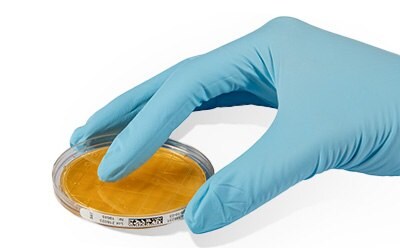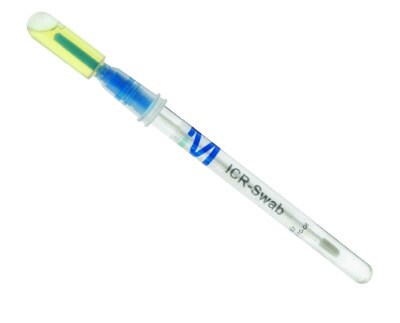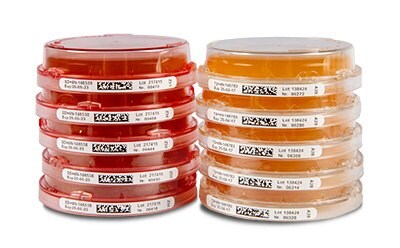Contact Plates and Swabs for Personnel and Surface Monitoring
Surface and personnel monitoring play a vital role in the health and pharmaceutical industries, where maintaining clean production environments is essential to minimize contamination risks. To monitor the efficiency of these proven measures, reliable tools such as user-friendly contact plates, contact slides, and swabs are necessary.
Section Overview
We offer an extensive selection of contact plates, contact slides, and swabs tailored to meet cleanroom standards and accommodate various surface types. Our monitoring solutions comply with the diverse standards of different countries, ensuring product safety on a global scale.
Surface & Personnel Monitoring Solutions for Critical and Non-Critical Areas
We offer triple-bagged, irradiated ICR/ICRplus contact plates, which are complemented by our ICR Swabs designed for presence-absence testing of hard-to-reach areas like filling needle tubing, making them ideal for environmental monitoring of surfaces in these critical environments, including ISO 5 cleanrooms and isolators. For less critical environments, we offer single-bagged, non-irradiated RT/RTplus contact plates.
To minimize contamination risks, the contact plates are manufactured in cleanroom conditions. They can be stored at room temperature, and the ICRplus/RTplus formats are lockable, allowing for safe transport and incubation in aerobic, microaerophilic, or anaerobic environments.

Figure 1: Contact Plate filled with agar media
The contact plates are filled with Tryptic Soy Agar (TSA), Sabouraud Dextrose Agar (SDA), or a non-animal, vegetable peptone medium to minimize the risk of BSE/TSE contamination. Additionally, these plates can be supplemented with neutralizers to counteract various disinfectants or β-lactam antibiotics, ensuring effective monitoring of sanitized, dry surfaces. Neutralizers like lecithin (L), Tween 80 (T), histidine (H), and sodium thiosulfate (Th/Thio) are included to neutralize disinfectant residues commonly used worldwide. Plates supplemented with cephalosporinase, or penicillinase are used to inactivate a wide spectrum of β-lactam antibiotics.

Figure 2:ICR Plus Contact Plate
Irradiated and triple bagged contact plates are suitable for use in critical cleanrooms, RABS and isolators. They can be used for surface and personnel monitoring, but also for active air monitoring with MAS® air samplers. We offer two versions in a non-lockable (ICR) and lockable (ICR plus) format. The ICR plus version is furthermore suitable for anaerobic monitoring.
Secure and reliable
- CLOSED- or VENT-Closure: Safe transport and flexible incubation conditions
- 2D Data matrix barcode on each plate for secure identification of each plate
- Transparent, H2O2-impermeable triple-sleeve packaging for safe transportation in cleanrooms (ISO 5) and isolators
- Produced in controlled environment and irradiated in final packaging to minimize risk of contamination
Convenient
- Storage at room temperature
- Long shelf life allows fewer incoming goods controls
- SDA in pink plates easily distinguish between TSA and SDA
Flexible
- Many different formulations for the monitoring of sanitized, dry surfaces
- Supplemented by neutralizers for a wide range of disinfectants and β-lactam antibiotics
- Media with non-animal origin, minimizes the risk of BSE contamination
Customer Feedback
Olga Defterigou, Senior Microbiology Lab Manager at Elpen Pharmaceutical Co. Inc.:
"The culture medium of contact plates has excellent growth promoting properties. The wrap is superior to others, durable with easy opening. The desiccant greatly limits the creation of moisture. A gold standard for surface testing of grade A/B areas and gowning testing of aseptic operators."

Figure 3:ICR swab for effective sampling in isolators and cleanroom environments
ICR Swabs are designed for absence-presence testing on dry surfaces in isolators and cleanrooms that are challenging to access for surface and personnel monitoring. The snap valve design of the swab ensures convenient and safe handling. The swab tip is made from low-abrasion material, minimizing particle release during use. Additionally, the moistening solution on the tip does not leave any growth-promoting residues on the sampled surfaces. The medium used is Tryptic Soy Broth (TSB), supplemented with neutralizers to create optimal growth conditions, in accordance with pharmacopoeia recommendations.
- Minimizes cross-contamination risks with a closed system that requires only a single opening for sampling and testing.
- Each swab is triple-bagged and irradiated to minimize contamination risks in clean rooms.
- The swab tip is pre-moistened with NaCl solution; it prevents growth-promoting residues on sample surfaces.
- Features a 2D data matrix barcode for secure tracking of individual swabs.
- Effective in the presence of several antimicrobial residues such as hydrogen peroxide and a broad range of residues of disinfectants.
- Can be stored up to room temperature and involves minimal procedural steps for ease of use.

Figure 4:IRT and RT Plus Contact Plates for Microbial Monitoring
Our RT and RT Plus contact plates are designed for microbial monitoring of dry surfaces such as floors, walls, textiles and working garments of personnel in controlled areas.
Formulations are available for determining total aerobic microbial count (Tryptic Soy Agar = Casein Soya Bean Digest Agar = TSA or Plate Count Agar= PCA), yeast and mold count and total count for specified microorganisms. When monitoring sanitized surfaces plates neutralizers such as lecithin (L), tween 80 (T); histidine (H) and sodium thiosulfate (Th/Thio) can inactivate a wide range of disinfectants.
Secure and Reliable
- 2D Data matrix barcode on each plate
- Safe and paperless identification of individual plates
Convenient
- Room temperature stability
- Storable at site of use
Lid in CLOSED Position
- Safe transportation from sampling area to the lab
- Recommended for prolonged aerobic incubation period
Lid in VENT Position
- Mandatory for incubation under microaerophilic or anaerobic conditions
- Suitable also for short-term incubation under aerobic conditions
ICR Plus Contact Plates
ICR Contact Plates & ICR Swabs
RT Media Plates
Accessories
To continue reading please sign in or create an account.
Don't Have An Account?